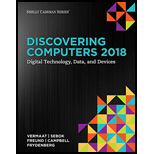
Discovering Computers ©2018: Digital Technology, Data, and Devices
1st Edition
ISBN: 9781337285100
Author: Misty E. Vermaat, Susan L. Sebok, Steven M. Freund, Jennifer T. Campbell, Mark Frydenberg
Publisher: Cengage Learning
expand_more
expand_more
format_list_bulleted
Question
Chapter 10, Problem 34SG
Program Plan Intro
Network Card:
- Network card is used to connect a computer to another
computer network and it is one of the main hardware components of a computer. - It is an interface between a computer and a network cable.
- It is also known as Network Interface Card.
- There are two types of network card;
- Wireless network card
- (Universal Serial Bus) USB network card
Expert Solution & Answer
Trending nowThis is a popular solution!

Students have asked these similar questions
4. |z + 5 - 5i| = 7
14.
dz,
C: |z❘
C: |z❘ = 0.6
ze² - 2iz
H
14.
dz,
C: |z❘
C: |z❘ = 0.6
ze² - 2iz
H
Chapter 10 Solutions
Discovering Computers ©2018: Digital Technology, Data, and Devices
Ch. 10 - Prob. 1SGCh. 10 - Prob. 2SGCh. 10 - Prob. 3SGCh. 10 - Prob. 4SGCh. 10 - Prob. 5SGCh. 10 - Prob. 6SGCh. 10 - Prob. 7SGCh. 10 - Prob. 8SGCh. 10 - Prob. 9SGCh. 10 - Prob. 10SG
Ch. 10 - Prob. 11SGCh. 10 - Prob. 12SGCh. 10 - Prob. 13SGCh. 10 - Prob. 14SGCh. 10 - Prob. 15SGCh. 10 - Prob. 16SGCh. 10 - Prob. 17SGCh. 10 - Prob. 18SGCh. 10 - Prob. 19SGCh. 10 - Prob. 20SGCh. 10 - Prob. 21SGCh. 10 - Prob. 22SGCh. 10 - Prob. 23SGCh. 10 - Prob. 24SGCh. 10 - Prob. 25SGCh. 10 - Prob. 26SGCh. 10 - Prob. 27SGCh. 10 - Prob. 28SGCh. 10 - Prob. 29SGCh. 10 - Prob. 30SGCh. 10 - Prob. 31SGCh. 10 - Prob. 32SGCh. 10 - Prob. 33SGCh. 10 - Prob. 34SGCh. 10 - Prob. 35SGCh. 10 - Prob. 36SGCh. 10 - Prob. 37SGCh. 10 - Prob. 38SGCh. 10 - Prob. 39SGCh. 10 - Prob. 40SGCh. 10 - Prob. 41SGCh. 10 - Prob. 42SGCh. 10 - Prob. 43SGCh. 10 - Prob. 44SGCh. 10 - Prob. 45SGCh. 10 - Prob. 46SGCh. 10 - Prob. 47SGCh. 10 - Prob. 48SGCh. 10 - Prob. 49SGCh. 10 - Prob. 1TFCh. 10 - Prob. 2TFCh. 10 - Prob. 3TFCh. 10 - Prob. 4TFCh. 10 - Prob. 5TFCh. 10 - Prob. 6TFCh. 10 - Prob. 7TFCh. 10 - Prob. 8TFCh. 10 - Prob. 9TFCh. 10 - Prob. 10TFCh. 10 - Prob. 11TFCh. 10 - Prob. 12TFCh. 10 - Prob. 1MCCh. 10 - Prob. 2MCCh. 10 - Prob. 3MCCh. 10 - Prob. 4MCCh. 10 - Prob. 5MCCh. 10 - Prob. 6MCCh. 10 - Prob. 7MCCh. 10 - Prob. 8MCCh. 10 - Prob. 1MCh. 10 - Prob. 2MCh. 10 - Prob. 3MCh. 10 - Prob. 4MCh. 10 - Prob. 5MCh. 10 - Prob. 6MCh. 10 - Prob. 7MCh. 10 - Prob. 8MCh. 10 - Prob. 9MCh. 10 - Prob. 10MCh. 10 - Prob. 2CTCh. 10 - Prob. 3CTCh. 10 - Prob. 4CTCh. 10 - Prob. 5CTCh. 10 - Prob. 6CTCh. 10 - Prob. 7CTCh. 10 - Prob. 8CTCh. 10 - Prob. 9CTCh. 10 - Prob. 10CTCh. 10 - Prob. 11CTCh. 10 - Prob. 12CTCh. 10 - Prob. 13CTCh. 10 - Prob. 14CTCh. 10 - Prob. 15CTCh. 10 - Prob. 16CTCh. 10 - Prob. 17CTCh. 10 - Prob. 18CTCh. 10 - Prob. 19CTCh. 10 - Prob. 20CTCh. 10 - Prob. 21CTCh. 10 - Prob. 22CTCh. 10 - Prob. 23CTCh. 10 - Prob. 24CTCh. 10 - Prob. 25CTCh. 10 - Prob. 26CTCh. 10 - Prob. 27CTCh. 10 - Prob. 1PSCh. 10 - Prob. 2PSCh. 10 - Prob. 3PSCh. 10 - Prob. 4PSCh. 10 - Prob. 5PSCh. 10 - Prob. 6PSCh. 10 - Prob. 7PSCh. 10 - Prob. 8PSCh. 10 - Prob. 9PSCh. 10 - Prob. 10PSCh. 10 - Prob. 11PSCh. 10 - Prob. 1.1ECh. 10 - Prob. 1.2ECh. 10 - Prob. 1.3ECh. 10 - Prob. 2.1ECh. 10 - Prob. 2.2ECh. 10 - Prob. 2.3ECh. 10 - Prob. 3.1ECh. 10 - Prob. 3.2ECh. 10 - Prob. 3.3ECh. 10 - Prob. 4.1ECh. 10 - Prob. 4.2ECh. 10 - Prob. 4.3ECh. 10 - Prob. 1IRCh. 10 - Prob. 2IRCh. 10 - Prob. 3IRCh. 10 - Prob. 4IRCh. 10 - Prob. 5IRCh. 10 - Prob. 1CTQCh. 10 - Prob. 2CTQCh. 10 - Prob. 3CTQCh. 10 - Prob. 4CTQ
Knowledge Booster
Similar questions
arrow_back_ios
SEE MORE QUESTIONS
arrow_forward_ios
Recommended textbooks for you
 Enhanced Discovering Computers 2017 (Shelly Cashm...Computer ScienceISBN:9781305657458Author:Misty E. Vermaat, Susan L. Sebok, Steven M. Freund, Mark Frydenberg, Jennifer T. CampbellPublisher:Cengage Learning
Enhanced Discovering Computers 2017 (Shelly Cashm...Computer ScienceISBN:9781305657458Author:Misty E. Vermaat, Susan L. Sebok, Steven M. Freund, Mark Frydenberg, Jennifer T. CampbellPublisher:Cengage Learning A+ Guide to Hardware (Standalone Book) (MindTap C...Computer ScienceISBN:9781305266452Author:Jean AndrewsPublisher:Cengage Learning
A+ Guide to Hardware (Standalone Book) (MindTap C...Computer ScienceISBN:9781305266452Author:Jean AndrewsPublisher:Cengage Learning Systems ArchitectureComputer ScienceISBN:9781305080195Author:Stephen D. BurdPublisher:Cengage Learning
Systems ArchitectureComputer ScienceISBN:9781305080195Author:Stephen D. BurdPublisher:Cengage Learning Principles of Information Systems (MindTap Course...Computer ScienceISBN:9781305971776Author:Ralph Stair, George ReynoldsPublisher:Cengage Learning
Principles of Information Systems (MindTap Course...Computer ScienceISBN:9781305971776Author:Ralph Stair, George ReynoldsPublisher:Cengage Learning

Enhanced Discovering Computers 2017 (Shelly Cashm...
Computer Science
ISBN:9781305657458
Author:Misty E. Vermaat, Susan L. Sebok, Steven M. Freund, Mark Frydenberg, Jennifer T. Campbell
Publisher:Cengage Learning

A+ Guide to Hardware (Standalone Book) (MindTap C...
Computer Science
ISBN:9781305266452
Author:Jean Andrews
Publisher:Cengage Learning

Systems Architecture
Computer Science
ISBN:9781305080195
Author:Stephen D. Burd
Publisher:Cengage Learning

Principles of Information Systems (MindTap Course...
Computer Science
ISBN:9781305971776
Author:Ralph Stair, George Reynolds
Publisher:Cengage Learning
